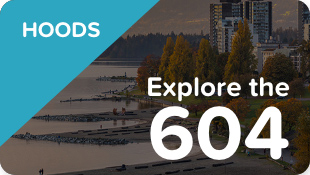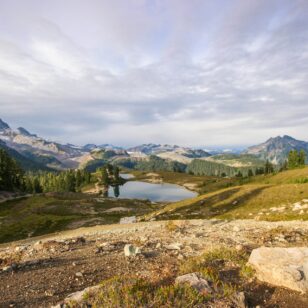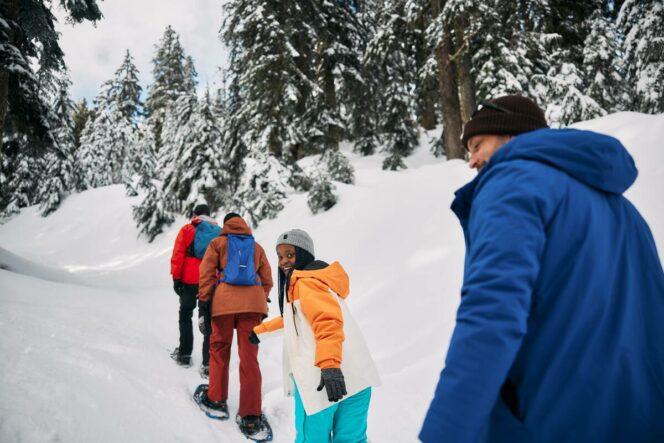
Snowshoeing at Grouse Mountain. Photo: Destination Vancouver/Kindred & Scout
We get all kinds of weather in Vancouver in winter from mild and wet days to cold and snowy ones. And the weather is different in the city than it is up in the mountains. Our Vancouver winter packing list for outdoor adventures has tips for what to bring for all conditions.
Winter Weather in Vancouver
Vancouver’s coastal climate means that it is usually not very cold in winter. Typical temperatures in December, January, and February are 3 to 8(37 to 47
However, winter in Vancouver can be rainy. On average, it rains 19 days a month in December, January, and February. Sometimes it rains all day, but often, it drizzles in fits and starts, with clear periods in between. Vancouver also gets a little bit of snow in the city – usually about 8 cm (3″) in December, 12 cm (5″) in January and 5 cm (2″) in February.
It’s important to keep in mind that while it may be warm and raining at sea level, the mountains are a different beast. If you are heading up to the peaks in winter, be prepared for below-freezing temperatures, snow, and ice. Vancouver’s local mountains get about 30 cm (1 foot) of snow each week in winter.
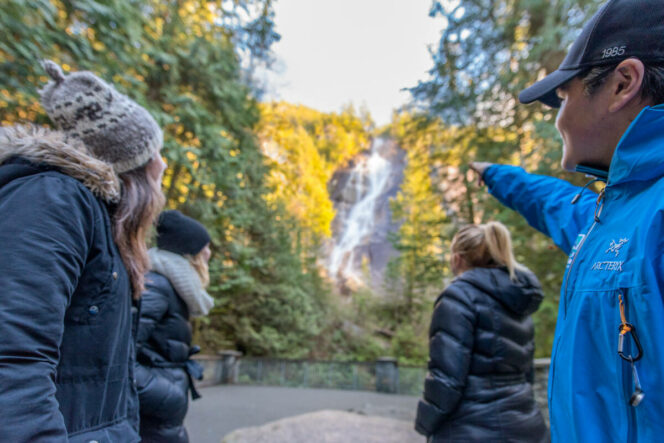
Hikers bundled up for winter at Shannon Falls in Squamish. Photo: Destination Vancouver/Landsea Tours Ltd.
What to Pack for Winter Outdoor Adventures
In winter, Vancouver’s weather can be both cold and damp. That’s why it’s important to dress in warm and waterproof layers so you can add or remove clothes as the temperature changes or the rain or snow stops and starts.
Look for quick-drying synthetic or wool clothing. Hiking, skiing, or outdoor-specific clothing is the best option. Avoid anything made with cotton as it won’t keep you warm if it gets wet.
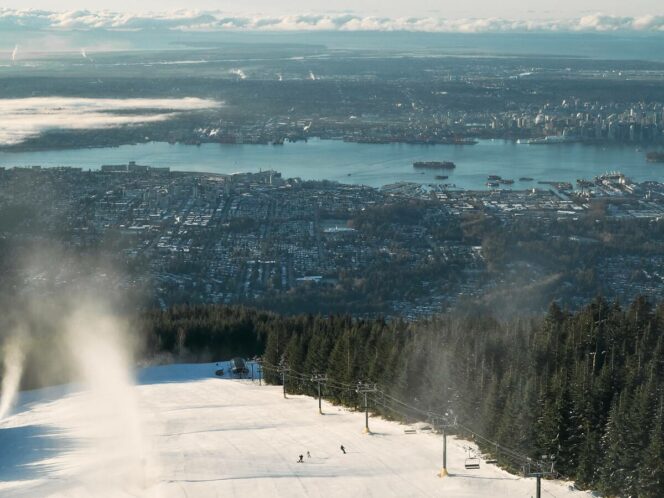
Skiing at Grouse Mountain. Photo: Destination Vancouver/Kindred & Scout.
Here’s a quick packing list for winter hiking, snowshoeing, and skiing in Vancouver:
Waterproof Jacket: Look for ones rated waterproof, not water-resistant. If you plan to hike, snowshoe, or ski, choose ones with waterproof breathable technology. They let sweat escape without letting rain in. This is the outermost layer in your layering system.
Fleece or Puffy Jacket: This middle layer will add warmth in chilly temperatures. Make sure it fits under your waterproof jacket.
Thermal Long Underwear Shirt and Pants: This layer goes next to your skin to wick sweat while keeping warmth in. Midweight long underwear is the best choice for most people – heavyweight ones are usually too hot in our mild climate.
Quick-Dry Hiking Pants or Tights: For hikes closer to sea level in dry weather, you can layer quick-dry hiking pants over your thermal long underwear.
Waterproof Rain Pants or Ski Pants: If you plan to hike in the rain or head up to the mountains to snowshoe or ski, you will need some waterproof rain pants or ski pants. For the best performance, choose ones with waterproof breathable technology. For skiing or snowshoeing, choose pants with some insulation to keep you warm.
Waterproof Hiking Boots or Snowboots: If you hike or snowshoe, you will need waterproof hiking boots or snowboots. Don’t wear running shoes unless you want cold and wet feet.
Warm Socks: Keep your feet warm with a pair of warm socks. Make sure the ones you choose fit inside your boots – don’t go too thick. Merino wool socks provide lots of warmth without too much bulk.
Ski/Snowboard Equipment: You can bring your own skis, snowboard, boots, poles, and helmet from home. But local ski hills and gear shops also have tons of rental options.
Microspikes or Snowshoes: If you are planning to hike in winter, you need to be prepared for ice and snow. If the trails or icy or have hard-packed snow, you can wear microspikes. These easy-to-use devices have strong metal spikes on the bottom and slip over the soles of your boots. In deeper snow, you will sink without snowshoes. You can rent them at ski hills and gear shops around Vancouver.
Trekking Poles: In winter’s slippery conditions, trekking poles are very handy for keeping your balance on ice and snow. Most gear shops that rent snowshoes also rent poles.
Sunglasses or Goggles: When the sun comes, out the snow can be blindingly bright. Any sunglasses or goggles will work, but polarized ones are best at cutting down the glare.
Sunscreen and Lip Balm: Protect your skin from the sun and wind. The reflections from snow can cause burns faster than you realize.
Warm Hat: Canadians call it a toque and Americans call it a beanie. No matter what you call it, bring a warm hat to fend off chilly weather.
Neck Gaiter or Buff: Protect your neck and face from the cold with a neck gaiter (also known as a buff). Choose ones made of fleece or wool for the most warmth. You can also use a scarf, but they are bulkier and can be dangerous on chairlifts.
Gloves: In mild weather, pack lightweight fleece or wool gloves. In the cold or rain, waterproof and insulated ski gloves are best.
Handwarmers: If you get cold hands easily, bring a rechargeable electric handwarmer or chemical handwarmers to tuck into your gloves.
Water Bottle: Even if you aren’t sweating too much, it’s easy to get dehydrated. Most hikers need about 0.5L of water per hour. While Vancouver’s mountain streams may look pristine, the water isn’t safe to drink without filtering or purifying. Pack lots of water. An insulated water bottle or Thermos will keep your water from freezing.
Snacks: Pick up a sandwich or pastry at one of Vancouver’s great cafes, then enjoy it on the trails. Pack some granola bars, trail mix, or candy for extra energy.
The 10 Essentials: AdventureSmart recommends bringing a backpack with essential safety and first aid gear on every trip. Read through the full list of equipment on their site for a great run-down on the things you need to bring to have a safe and fun hike, snowshoe, or ski day.
Backpack: Bring a backpack to carry your extra layers, water, snacks, and safety gear. Look for one that has a capacity of 15-30 litres.
Winter Hiking Tips
Looking for more winter hiking tips? Get advice on weather forecasts, avalanche awareness, sunset times, and more in our guide to safe winter hiking in Vancouver.
Winter Outdoor Adventures in Vancouver
There are tons of options for winter outdoor adventures around Vancouver. Snowshoeing is one of the easiest winter sports to master. Our guide to the best easy snowshoe trails near Vancouver has tips for getting started. If you’re into skiing or snowboarding, read our run-down on everything you need to know about skiing near Vancouver in winter 2023/24. And if snow isn’t your thing, check out our picks for 9 snow-free hikes near Vancouver.










